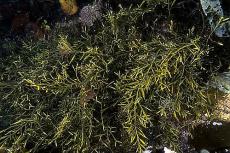Eat kelp
Did you know that kelp is an ingredient in many household foods! Foods like frozen foods, cakes, puddings, salad dressings, shampoos, and toothpastes contain alginate. Alginate is an apparently safe derivative of seaweed (kelp), and is used to maintains the desired texture in many products.
Giant kelp is one of the fastest growing plants in the world. When conditions are good, kelp can grow two feet per day! Giant kelp prefers water temperature in the 50-65°F range. Kelps occurs at and below low-tide levels in cool temperate regions throughout the world. They are a group of large brown seaweeds that live on the rocky sea bed as far down as sunlight penetration will allow.
The plants often grow together in large numbers to form dense forests, usually composed of a single kelp species. A giant kelp plant can live up to six years. The plant is continuously pushing up new fronds to the surface, while the older fronds break off. Reaching lengths of more than 30 meters, it is the largest marine algae.
The rainforest of the ocean
The kelp forest has a high production and very high biological diversity. Kelp forests are among the most productive and species-rich ecosystems in the world. Kelp plants create a structural complexity throughout the water column that provides habitat for many kinds of fish, invertebrates and other algae. This makes the kelp forest an amazing place to scuba dive. If coral reefs are said to be the cities of the ocean, the kelp forests have to be the rain forest of the ocean.
In the shadows within the kelp forest, hundreds of species of fishes and invertebrates ply their trades. The kelp forest also offers a great place to grow offspring. Many vulnerable larvae of fish spend their formative months in the kelp forest instead of having to face the dangers of the open ocean.
Just as in the rain forest on land, the kelp forest houses different species at different levels. While some fish thrive under the canopy, other animals make their lives further down in the aquatic forest. Various predatory snails and gaily colored nudibranchs graze on the stem and the kelp leaves. Within the labyrinth of the kelp forest, many shrimp, crabs, sea stars and anemones also find their food and housing. Scientists have counted up to 100,000 life forms on a single kelp.
Kelp harvesting
Kelp harvesting takes place in several countries around the world. The harvesting of kelp for the manufacture of food additives and agrochemical products is a significant business in Asia, Europe and parts of North America. Giant kelp has been harvested off the southern California coast for more than 90 years. In the 1970’s, yearly harvests of more than 170,000 tons supported a California kelp industry worth US$40 million. Also ...
(...)
Download the full article ⬇︎

Originally published
X-Ray Mag #15
Cave Diving theme issue. YUCATÀN - Mexico's "Riviera Maya" :: Varonya Cave in Caucasus :: How Caves are created :: Interview with pioneer Bill Stone :: Equipment and training. Shopping for Valentine's Day - New Equipment: REGULATORS: How to chose - How do the Work - Freezing & FreeFlowing - Understanding the Breathing Diagram. SCIENCE: Visibility Tech: The Lady and the president. Profile: Sue Dudas




































